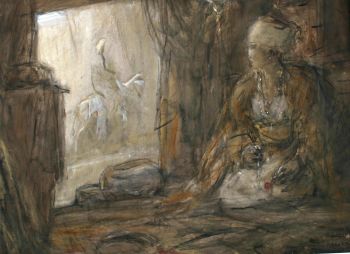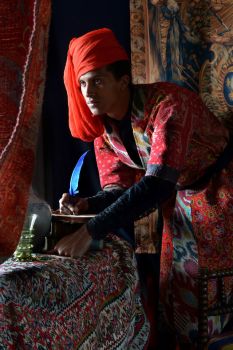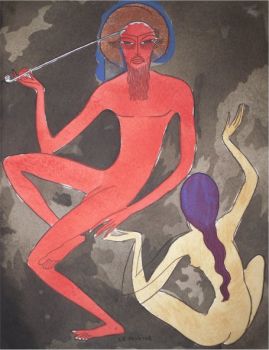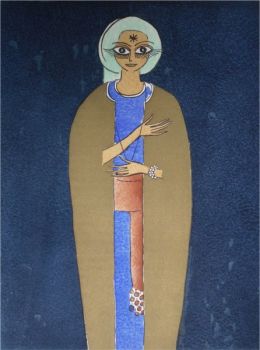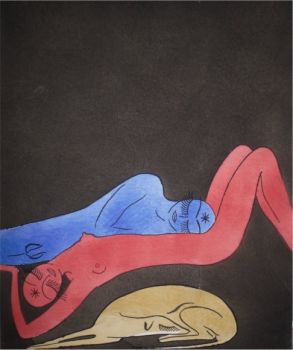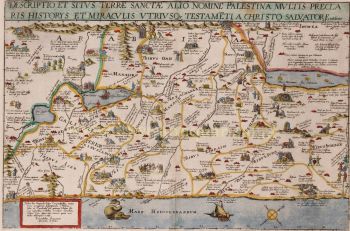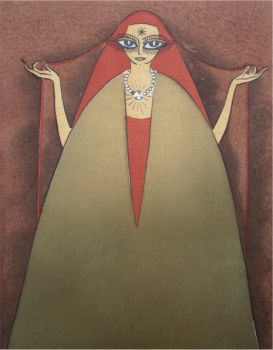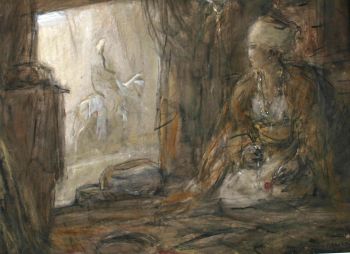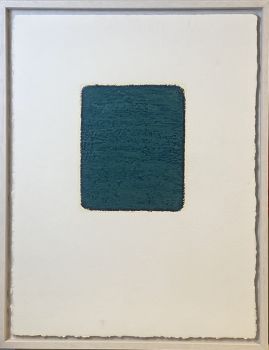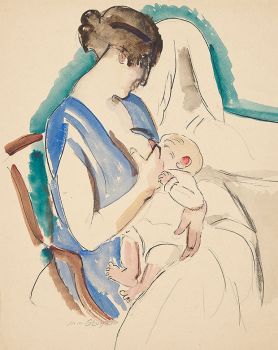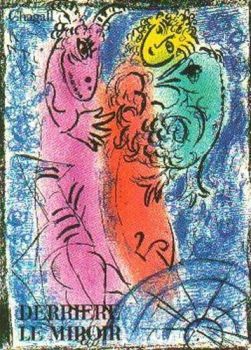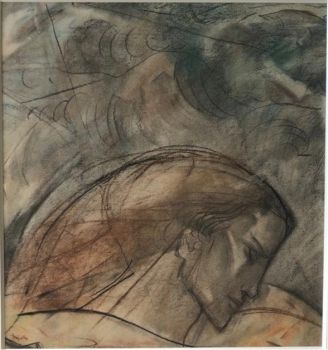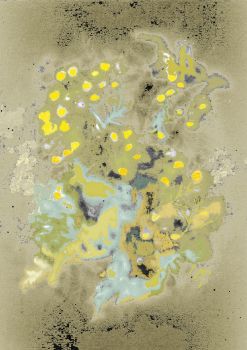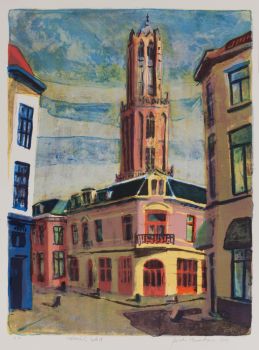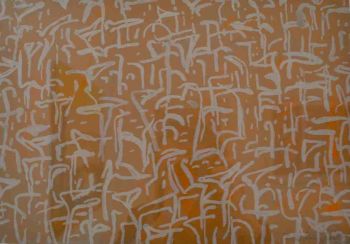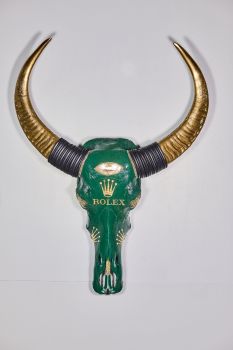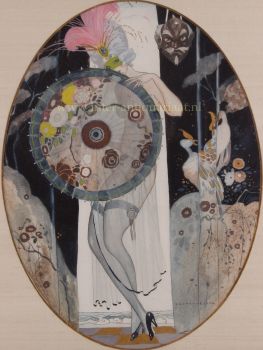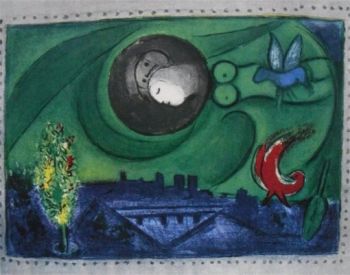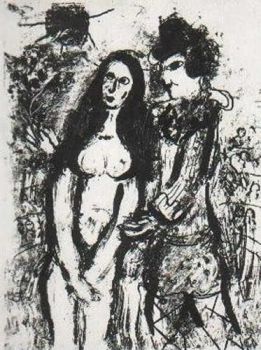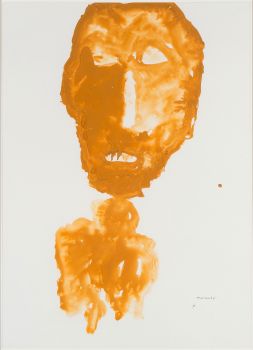Printed and bound at the first Arabic printing office in Lebanon 1776
Monastery of Saint John the Baptist at Dayr al-Shuwayr
PapelCuero
Actualmente no disponible a través de Gallerease
- Sobre la obra de arteKitab al-Injil al-sharif al-tahir wa-al-misbah al-munir al-zahir muqassaman kanayisiyan madar al-sanah hasaba tartib al-Anba al-Qiddisiyin al-Sharqiyin [= Book of the liturgical Gospels].
Dayr al-Shuwayr (or Dhour el Choueir, in Lebanon), Dayr Mar Yuhanna [= Monastery of Saint John the Baptist], [1776]. Folio (31.5 x 22.5 cm). A Greek Melkite Evangeliary in Arabic, with each page in a border of thick-thin rules, pp. 245-300 printed in red and black, and a woodcut Madonna and child. The title-page has been sophisticated, probably in the 18th-century, and appears to be a badly inked proof that has been touched up in manuscript. Bound by the Dayr al-Shuwayr Monastery in contemporary gold- and blind-tooled reddish-brown goatskin morocco, each board with a gold centrepiece.
Very rare second Arabic edition (the first to be printed in Lebanon) of the four Gospels arranged for liturgical use in the Greek Melkite Church, to make readings for services according to the day of the year: a so-called Evangeliary or Evangelion. It was intended primarily for Arabic-speaking Christians in the Middle East, rather than for missionary work. The first Arabic edition was printed and published at Aleppo in 1706. Al-Shamas Abdallah Zakher (1684-1748), son of an Aleppo goldsmith, worked at the Aleppo printing office but had to flee in 1722 because of disputes that were to lead to the 1724 schism in the Melkite Church. Zakher established the printing office of the Melkite monastery of St. John the Baptist at Dayr al-Shuwayr in the Lebanese Kisrawan mountains, where he produced a psalter in 1734. He is said to have been skilled in jewelry-making and cutting in metal and wood, and to have cut the punches for the 1734 Arabic type. The printing office produced about 70 Arabic editions before it closed in 1899.
With marginal manuscript notes in Arabic script, the stamp of a Diyarbakir (in Anatolia, eastern Turkey) library in the margin of the last page. With the title-page sophisticated as noted, some mostly marginal water stains, an occasional small stain, a tiny and unobtrusive worm hole in the second half, but mostly in good condition and with large margins. The binding rubbed and slightly chipped, with the front hinge and fore-edge corners restored and the inside front hinge reinforced. Very rare early example of an Arabic liturgical work, printed and bound at the Monastery of St John the Baptist in Dayr al-Shuwayr, Lebanon.
Darlow & Moule 1661; KVK & WorldCat (3 copies); Schnurrer 360; for Zakher: J.E. Kahale, Abdallah Zakher (2000); Hanebutt-Benz et al., Middle Eastern languages and the print revolution (2002), pp. 179-181. - Sobre el artistaLa Orden Basiliana Chouerita de San Juan Bautista es una orden religiosa de la Iglesia greco-católica melquita. El nombre latino de esta orden es Ordo Basilianus Sancti Iohannis Baptistae, el nombre francés es Ordre Basilien Chouerite de Saint Jean Baptiste, la abreviatura utilizada después del nombre es B.C. Esta orden fue encontrada en 1696 por cinco monjes (incluido Neophytos Nasri) que abandonaron el Monasterio de Balamand para buscar un lugar tranquilo donde seguir mejor la regla de San Basilio. Se establecieron en 1710 en el pueblo de Choueir (o Dhour El Shuwayr, cerca de Khinchara) en el Monte Líbano utilizando la pequeña iglesia de San Juan Bautista, de la que tomaron el nombre y que sigue siendo su casa madre En 1733 Abdallah Zakher estableció una Imprenta en árabe con tipos móviles en el monasterio de San Juan de Choueir, la primera imprenta casera del Líbano. En 1757 el Papa Benedicto XIV aprobó sus reglas particulares, y la aprobación final de Roma se dio en 1772. La Orden Basiliana Salvatoriana pronto se convirtió en una de las dos principales órdenes religiosas de la Iglesia Católica Melquita. La otra orden fue la Orden Basiliana Salvatoriana. Según su tradición, la Orden Basiliana Salvatoriana tenía un objetivo más misionero, mientras que la Orden Basiliana Chouerita era más contemplativa. La Orden Basiliana Salvatoriana reclutó en las áreas de Damasco y el sur del Líbano, mientras que la Orden Basiliana Chouerite reclutó en las áreas de Alepo, Homs, Norte del Líbano y Galilea. Los intentos de unir estos dos órdenes en el siglo XVIII fracasaron: la oposición entre ellos y entre las diferentes comunidades de las que reclutan miembros es un aspecto importante a comprender en la historia temprana de la Iglesia católica melquita. Entre 1824 y 1832 la orden se dividió en dos ramas: la Orden Basiliana Alepiana (formada principalmente por monjes que venían del área de Alepo), y la Orden Baladitas o Basiliana Chouerita (que provenía principalmente del Líbano y Galilea). La orden fundó su seminario en 1880 y dirige muchas parroquias en el Medio Oriente. Tres patriarcas melquitas y unos 36 obispos eran miembros de los choueritas basilianos. La primera edición árabe se imprimió y publicó en Alepo en 1706. Al-Shamas Abdallah Zakher (1684-1748), hijo de un orfebre de Alepo, trabajaba en la imprenta de Alepo pero tuvo que huir en 1722 porque de disputas que conducirían al cisma de 1724 en la Iglesia Melquita. Zakher estableció la imprenta del monasterio melquita de San Juan Bautista en Dayr al-Shuwayr en las montañas libanesas de Kisrawan, donde produjo un salterio en 1734. Se dice que era experto en la fabricación de joyas y el corte de metal y madera, y haber cortado los punzones para el tipo árabe de 1734. La imprenta produjo alrededor de 70 ediciones en árabe antes de cerrar en 1899.
Artwork details
Related artworks
Engelbert Kaempfer
LIBRO DE ENGELBERT KAEMPFER1651 - 1716
Precio a consultarZebregs & Röell - Fine Art - Antiques
Tilmanus Nicolaus Maastricht
Missale Romanum con monturas de plata holandesas1788 - 1792
Precio a consultarJacob J. Roosjen SRI
Antonie Derkinderen
Memory book Exhibition of Dutch Painting1892
Precio a consultarKunsthandel Pygmalion
LAWRENCE WEINER
"SKIMMING THE WATER [MENAGE A QUATRE]" Signed book plus small artwork2010 - 2014
Precio a consultarGallerease Selected
Tilmanus Nicolaus Maastricht
Missale Romanum con monturas de plata holandesas1788 - 1792
Precio a consultarJacob J. Roosjen SRI
Yoko Ono
YOKO ONO: "ARISING" SIGNED BOOK PLUS SMALL ARTWORK 2010 - 2014
Precio a consultarGallerease Selected
Antonie Derkinderen
Memory book Exhibition of Dutch Painting1892
Precio a consultarKunsthandel Pygmalion
1 - 4 / 22Artista Desconocido
IMPORTANTE Y RARO PINTURA INDIA DE ESTILO DE COMPAÑÍA EN MARFIL QUE REPRESENTA UN DESFILE1850 - 1900
Precio a consultarZebregs & Röell - Fine Art - Antiques
 curada por
curada porDanny Bree
Elisabeth Treskow
Lapislázuli afgano con incrustaciones de oro sobre un soporte de plata1950 - 1960
Precio a consultarJacob J. Roosjen SRI
1 - 4 / 24- 1 - 4 / 24

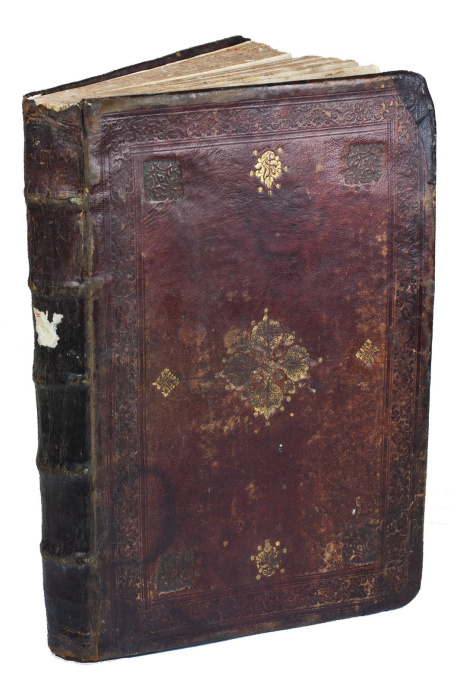








!["SKIMMING THE WATER [MENAGE A QUATRE]" Signed book plus small artwork by LAWRENCE WEINER](https://media-2.gallerease.com/images/442bfd5f-fc31-4e18-a2fa-ee0c08eade64/350x350/skimming-the-water-menage-a-quatre-signed-book-plus-small-artwork.jpg)












